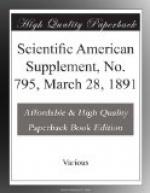During the first week the carbonaceous fed hens laid three eggs while the others laid two. The two groups were, therefore, practically evenly divided at the start as to the condition of the laying stage. At the end of the first period the nitrogenous fed hens had laid forty-three eggs and the carbonaceous fed hens had laid twenty. During the next twenty-five days the former laid thirty and the latter six; during the third period the former laid six and the latter not any. From this time on no eggs were received from either group. The decline in egg production was probably due in large part to the fact that the hens began to moult during the second period, and continued to do so during the rest of the experiment.
The eggs laid by the nitrogenous fed hens were of small size, having a disagreeable flavor and smell, watery albumen, an especially small, dark colored yolk, with a tender vitelline membrane, which turned black after being kept several weeks. While the eggs of the carbonaceous fed hens were large, of fine flavor, of natural smell, large normal albumen, an especially large, rich yellow yolk, with strong vitelline membrane, which was perfectly preserved after being kept for weeks in the same brine with the other eggs.
TOTAL FOOD CONSUMED DURING EXPERIMENT. ____________________________________________________________
_________ Lot. I.—Nitrogenous. | Lot. II.—Carbonaceous. _________________________________|__________________________
_________ | | | | | | Hens. |*Chicks| | Hens. |Chicks. |_______|_______| |_______|________ | lb. | lb. | | lb. | lb. Bran. | 29.90 | 21.85 | Maize. | 82.15 | 51.30 Shorts. | 29.90 | 21.85 | Green clover. | 18.75 | 18.75 Cotton seed meal.| 21.48 | 13.24 | Cabbage. | 16.00 | 16.00 Linseed meal. | 8.43 | 8.61 | Wheat | 15.63 | 11.71 Skimmed milk. |105.49 | 61.33 | | | Wheat. | 15.63 | 11.71 | | | Green clover. | 18.75 | 18.75 | | | Cabbage. | 16.00 | 16.00 | | | _________________|_______|_______|__________________|_______
|________ Total. |245.58 |173.34 | Total. |132.53 | 92.76 Nutritive ratio.| 1:3.1 | 1:3 | Nutritive ratio. | 1:7.8 | 1:8 _________________|_______|_______|__________________|_______
|________
* Calculated for five chicks, based upon the amount eaten by the three after the two sick were removed.
EGGS LAID AND GAIN IN WEIGHT—HENS. ____________________________________________________________
________ | | | Lot I. | Lot II. | Nitrogenous. | Carbonaceous. |______________|________________ | | Live weight, July 26. | 23.53 | 23.56 " " November 27. | 21.31 | 22.00 Loss. | 2.22 | 1.56




